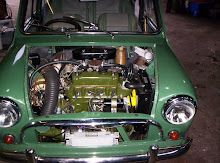Much of what has just been said regarding checking for air leakage in the pipeline, making sure that current is reach¬ing the pump and that the pump is properly earthed, applies equally to the later S.U. pump, illustrated in Fig. 31. It will be seen that in this case the pumping action is provided by a flexible fabric diaphragm which forms part of the armature assembly. Assuming that the contact points are closed, when the ignition is switched on current passes through the magnet coil and the magnet attracts the armature and diaphragm assembly. The movement
Later S.U. electrical fuel pump (type SP). Above, the body and Above, the body and pumping section. Below, the throw-over contact-breaker mechanism,
which is attached to the outer end of the magnet housing and the alternative
arrangement of the valves and filter
1. Fuel inlet 1. Gauze filter 3. Inlet valve A. Valve retainer
5. Earthing screw
6. Rubber sleeve
7. Magnet housing
8. Base casting
9. Outlet valve
10. Diaphragm and armature
with rollers
11. Diaphragm spring
12. Rocker mechanism
13. Rocker pivot pin
14. Rocker pedestal
15. Contact blade
16. Contact-breaker cover
17. Terminal tag
of the diaphragm draws petrol into the pumping chamber past the inlet valve, which is a disc of Melinex film.
As the armature moves forward the armature rod attached to it pushes over the rocker of the contact-breaker mechanism beneath the moulded cover at the outer end of the pump. As the armature approaches the end of its stroke a throw-over spring snaps the contact lever away from the fixed contacts, interrupting the current which is passing through the magnet coil. This allows the armature return spring to push the armature and diaphragm back, forcing the petrol out of the pumping chamber through the outlet valve (another Melinex film disc) and so through the delivery union into the pipeline to the carburettor.
The S.U. mechanically-operated pump: 1, outlet cover retaining screw; 2, outlet cover; 3, sealing ring; 4, filter; 5, outlet valve; 6, operating lever
The maintenance required by this pump is normally confined to an occasional inspection of the filter in the inlet union. On the SP pump this is a conical gauze in the inlet union (see Fig. 31). On the AUF pump the domed filter gauze is also beneath the inlet union, but in this case the inlet and outlet unions are retained by a plate secured by two screws. On this pump the unions also retain the Melinex valves. Otherwise the pump is similar to the SP type.
If the pump ticks erratically or fails to work, the most likely cause is dirty or carboned-up contacts. These can be cleaned, after the moulded cover has been removed, by passing a strip of card between them. Do not be tempted to alter the tension of the spring blade which carries the pair of stationary contacts and do not dismantle the pump further, as correctly adjusting the throw-over action on reassembly is a somewhat tricky process, best left to the expert.
In any event, as mentioned earlier, once a pump begins to give trouble the safest plan is to fit a reconditioned replacement under the manufac¬turer's exchange scheme. Unskilled attempts at putting the trouble right can result in the car being finally stranded late at night on a deserted road in the middle of a rainstorm!
The S.U. mechanical pump dismantled: 1, operating lever; 2, lever return spring; 3, diaphragm; 4, diaphragm spring; 5, combined inlet-outlet valve


0 comments:
Post a Comment